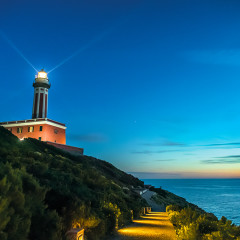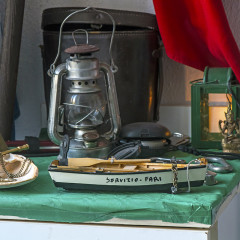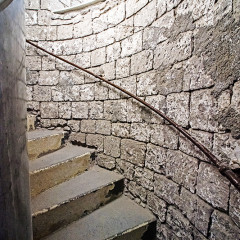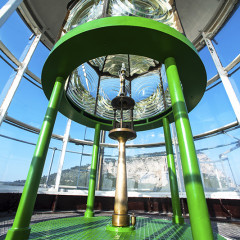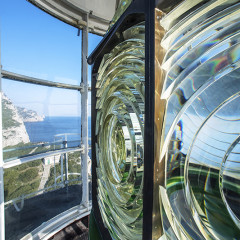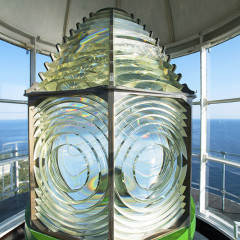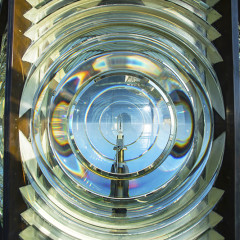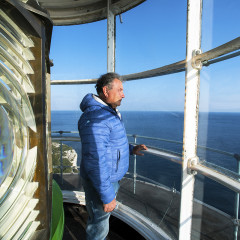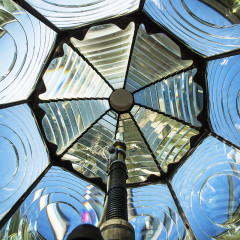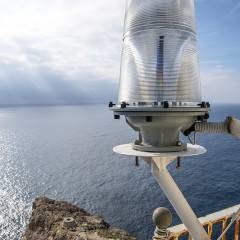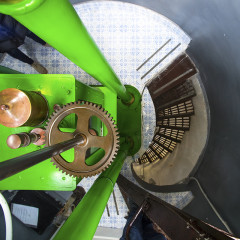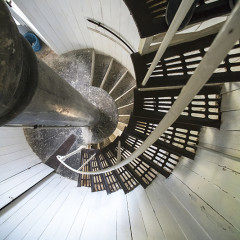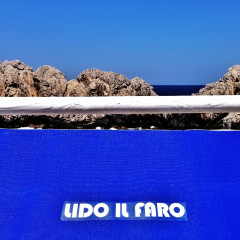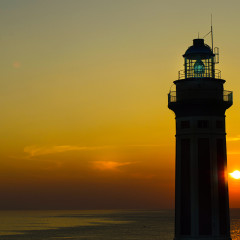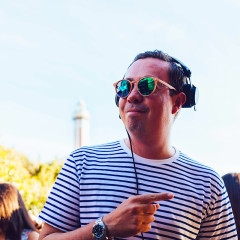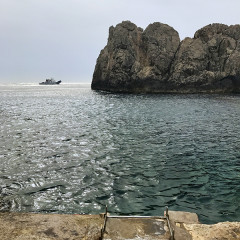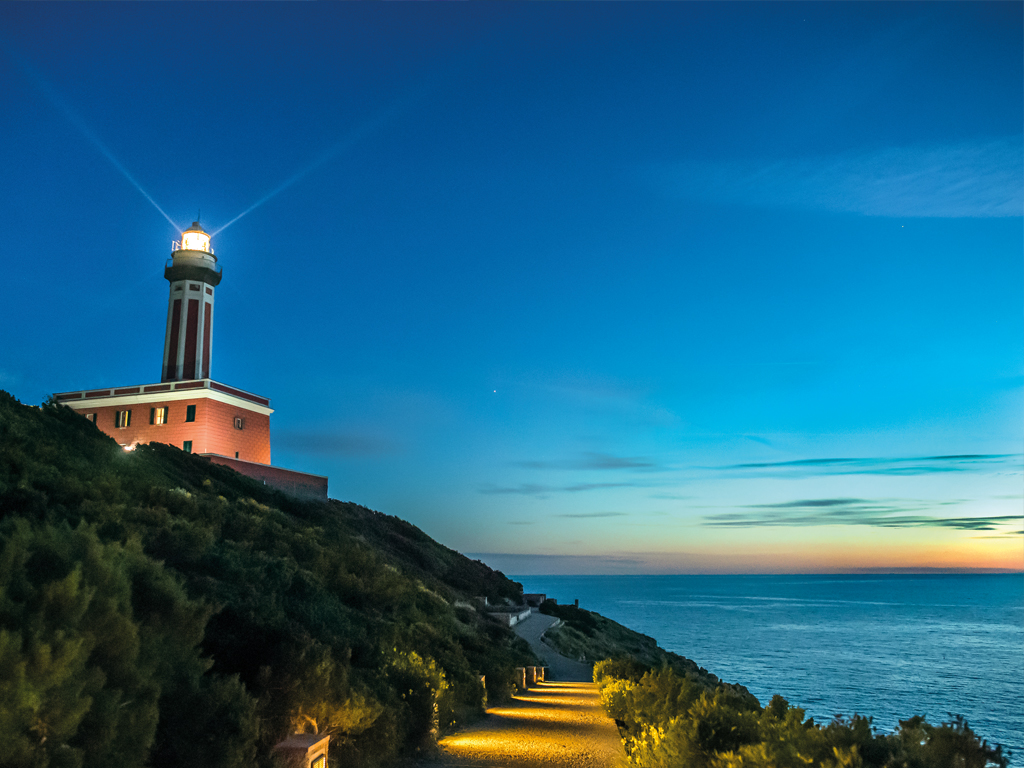
A guardia del mare
Posto a guardia della costa occidentale dell’isola, si staglia con il suo fascino senza tempo sul promontorio di costa rocciosa da cui prende il nome. Oltre c’è solo mare, fino alla Sicilia. | KEEPING WATCH OVER THE SEA. On guard over the west coast of the island, the silhouette of the lighthouse stands with a timeless fascination on the promontory of the rocky coast from which it takes its name. Beyond it there is only sea, as far as Sicily.
foto di | photos by Enrico Desiderio
150
Centocinquant’anni. Un secolo e mezzo di luce. È il 1° dicembre 1867 quando il fascio luminoso della lanterna del faro illumina per la prima volta quel tratto di mare aperto che entra nel golfo di Napoli. Il Regio Genio Civile, su progetto degli ingegneri del Regno Borbonico delle Due Sicilie, aveva avviato i lavori nel 1862. Per la sua costruzione erano stati utilizzati tufo grigio di Sorrento per il fabbricato e la torre ottagonale alta trenta metri e pietra lavica vesuviana a massello per la parte basamentale, il camminamento della lanterna e la scala a chiocciola interna. Dalle indagini storiche sembra che per realizzarlo ci siano volute 116.086,37 lire. Oggi il Faro di Punta Carena è uno dei più importanti del Mar Tirreno e secondo in Italia per portata luminosa. | A hundred and fifty years. A century and a half of light. It was on 1 December 1867 that the beam of light from the lighthouse lantern first illuminated that stretch of open sea that enters the gulf of Naples.The Royal Civil Engineers started work on the project in 1862 to designs by the engineers of the Bourbon Kingdom of the Two Sicilies. Grey Sorrento tuff was used for the building and the 30 metre high octagonal tower, while blocks of Vesuvian lava stone were used for the base, the walkway around the lantern and the spiral staircase inside. Historical records indicate that it cost 116,086.37 lire to build.Today the Lighthouse at Punta Carena is one of the most important lighthouses in the Tyrrhenian sea and ranks second in Italy in terms of luminous range.
La sua luce
Il Faro di Punta Carena è dotato di un’ottica rotante che emette lampi di luce bianca ogni 3 secondi. La lanterna si trova a 73 metri sul livello del mare e la sua luce ha una portata di 25 miglia marine (circa 46 km) e per questo viene definito “faro d’altura”. L’apparecchiatura originaria era lenticolare a splendori di 2’ in 2’ con luce fissa nelle falde ottiche superiori ed inferiori con una portata di luce di 20 miglia marine. Ancora oggi è un punto di riferimento per ogni natante, anche per quelli dotati delle più moderne strumentazioni dato che l’area è una “zona d’ombra” per qualsiasi segnale Gps. Le sue coordinate geografiche sono: latitudine nord 40°32’8’’, longitudine 11°51’37’’. | The light. The Punta Carena Lighthouse has a rotating optical lens system that emits white flashes of light every 3 seconds. The lantern is 73 metres above sea level and the beam has a range of 25 nautical miles (about 46 km) which is why it is known as an “off-shore lighthouse”. The original system was a lens system with brightness of 2’ in 2’ with a fixed beam in the upper and lower lens layers and a luminous range of 20 nautical miles. It is still a point of reference for all crafts in the area today, including those equipped with the most modern instruments, since the area is a “blind spot” for GPS signals. The geographical coordinates of the lighthouse are: latitude 40°32’8’’ north, longitude 11°51’37’’.
L’ultimo guardiano
Vive e lavora in solitudine. Attento custode della luce del faro e di quanto succede intorno. Ma fra due anni tutto sarà automatizzato
incontro con Carlo D’Oriano di Riccardo Esposito
Prendi l’autobus e arrivi al Faro di Punta Carena. Oppure segui il consiglio di quel signore che hai incrociato a Caprile: scendi a piedi passando per strade incorniciate da fiori e profumi, per una pineta arricchita dal canto delle cicale. Ha qualcosa di onirico la passeggiata che porta verso il mare, soprattutto perché il panorama è dominato dal faro. Un monumento che si sposa con la natura, e che rappresenta da sempre una certezza per marinai e capitani di lungo corso. Ma anche per turisti, residenti, villeggianti e pescatori.
Il faro è sempre al suo posto. Monolitico. Ma chi lo custodisce? Chi si occupa della sua manutenzione? C’è una casa tra quelle mura? Sì, c’è un guardiano del faro a Capri e si chiama Carlo D’Oriano. Nato nel 1954 ed entrato in Marina nel 1977, Carlo ha varcato per la prima volta la porta del faro nel 2005 diventando l’ultimo guardiano della luce di Punta Carena. Un lavoro per cui non basta amare la solitudine o la natura, bisogna conoscere il mare.
«La maggior parte dei faristi – racconta Carlo – ha un passato nelle Forze Armate, preferibilmente in Marina. Io prestavo servizio a Gaeta, lavoravo nella base navale come nocchiere poi è arrivata l’opportunità di trasferirmi nel faro di Capri e ho colto l’occasione al volo. I vecchi faristi sono andati quasi tutti in pensione e sono rimasto uno degli ultimi. Grazie alla mia esperienza in Marina so come gestire il faro e i soccorsi. Bisogna amare e rispettare il mare, saper capire le situazioni di pericolo per le navi perché spesso il faro è il primo orientamento per chi si trova in difficoltà».
Sfogliando i ricordi ritorna in mente una foto: un’onda titanica che si abbatte sul faro. Un’immagine inquietante ma affascinante allo stesso tempo. Così prende forma una domanda: qual è il rapporto tra un farista e la paura nei confronti di una natura spesso violenta? «Le onde non mi preoccupano – risponde Carlo. A volte la struttura vibra perché il mare investe tutto ma la colonna centrale è studiata per assorbire gli urti. Anche io però ho avuto paura, è stato nel 2013. Il 7 febbraio alle 21.05 un fulmine ha distrutto tutto, ha colpito il faro incendiando l’attrezzatura operativa e il mio appartamento, nonostante il parafulmine».
La natura sa essere implacabile, ma continuando la passeggiata verso Punta Carena sembra quasi che tutto qui sia stato pensato per rimanere in pace. Una pace che d’inverno si trasforma in isolamento e questo Carlo D’Oriano lo sa bene. «Vivo in solitudine, lavoro in solitudine. Ciò che mi consola è lo specchio d’acqua e la natura che mi circonda, ma l’inverno è difficile da affrontare, almeno all’inizio. Trascorro le mie ore a osservare l’orizzonte, leggo libri dedicati al mare e i lavori dei colleghi faristi che raccolgono le proprie esperienze su carta».
E Carlo quando scriverà un libro? «Ci sto pensando. Ho tante cose da mettere insieme e raccontare. Per ora mi sono appassionato alla condivisione del sapere faccia a faccia. Con Marevivo apriamo il faro ai bambini delle scuole; per me è importante condividere le conoscenze della mia professione».
Se l’inverno è un momento difficile da affrontare – soprattutto a Capri – d’estate tutto cambia. «Le persone che vanno al mare mi considerano una sorta di guardiano della zona, non solo dell’edificio. Questo per me è un privilegio, così come è importante essere un riferimento per chi ama la natura». Non tutti sanno, infatti, che il farista vigila sul funzionamento della lampada ma osserva anche l’orizzonte e riporta nel giornale di reggenza tutto ciò che succede nelle acque che circondano la struttura.
«Sono responsabile di tutti i fari dell’isola, quindi anche delle due luci all’ingresso del porto di Marina Grande e sul capo di Tiberio. Inoltre avviso e segnalo il passaggio dei delfini sul mio registro». Esatto, ci sono i delfini nel mare di Capri e Carlo D’Oriano conosce bene le abitudini di questi mammiferi. «Si fanno vedere dopo il tramonto, quando il mare è piatto. Il periodo? Settembre e ottobre, ma la vera emozione è quando dentro casa sento lo sbuffo delle balene, i famosi capodogli che hanno dato il nome allo scoglio che protegge la spiaggia. Quando passano avviso i ragazzi che rimangono vicino al fortino a vedere il tramonto, ed è sempre un’emozione».
Il guardiano del faro è il custode di tutto ciò che si trova nel raggio della luce. Una luce che emette lampi a intermittenza ogni 3 secondi e ha una visibilità di quasi 50 chilometri. Per Carlo ha un’importanza sacra. «Questo non è semplicemente un impiego, ma una dedizione. Per me è come una missione. Il faro è fondamentale per le navi ma anche per l’animo del marinaio. Tutto deve funzionare al meglio perché questa luce è importante, rincuora il capitano di lungo corso ma anche il pescatore».
Quindi il lavoro del farista è ancora indispensabile? «In realtà non più e anch’io tra due anni lascerò, ho terminato il mio periodo come farista e non ci sarà reintegro di personale. Tutto sarà computerizzato e questo un po’ mi rattrista. Saranno installati dei pannelli solari, sarà sostituita l’ottica con una luce a led che dura diversi anni. Con i sistemi di controllo a distanza tutto sarà più semplice, automatizzato».
Ma anche se Carlo D’Oriano lascerà il faro, questo edificio continuerà a vegliare sulla baia e con la sua luce rimarrà un punto di riferimento importante per tutti i naviganti.
The last lighthouse keeper
He lives and works in in solitude. Vigilant keeper of the lighthouse beam and all that takes place around it. He’ll be there for a further two years, after which it will all be automated
interview with Carlo D’Oriano by Riccardo Esposito
You can take the bus and arrive at the Punta Carena Lighthouse. Or you could take the advice of the man you met at Caprile: walk down, along streets wreathed in flowers and scents and through a pine wood ringing with the sound of cicadas. There’s something dreamlike about the walk that leads down to the sea, especially because the panorama is dominated by the lighthouse. It’s a monument that blends with the natural world, and has always been a certainty for sailors and for captains of ocean-faring vessels. But also for tourists, residents, holidaymakers and fishermen. The lighthouse is always there at its post. Monolithic. But who looks after it? Who is responsible for maintaining it? Is there a house between those walls? Yes, there is a lighthouse keeper on Capri and his name is Carlo D’Oriano. Carlo, who was born in 1954 and joined the Navy in 1977, first crossed the threshold of the lighthouse in 2005, becoming the last lighthouse keeper of Punta Carena. For this job, you not only need to love solitude and nature, but you must also know the sea. “Most lighthouse keepers have served in the armed forces, especially the Navy,” Carlo tells me. “I served at Gaeta, working in the naval base there as a harbour pilot and then I got the chance to move to the lighthouse on Capri and I jumped at it. The old lighthouse keepers have nearly all retired and I’m one of the last. With my experience in the Navy, I know how to manage the lighthouse and the rescue services. You need to love and respect the sea, and to be able to realise what situations are hazardous for ships, because the lighthouse is often the first means of orientation for people in difficulty.” As he goes over his memories, he recalls a photo: an enormous wave that crashed over the lighthouse. It’s an image that’s disturbing yet fascinating at the same time. And this raises the question: what part does fear play in situations where the lighthouse keeper faces often violent forces of nature? “The waves don’t bother me,” answers Carlo. “Sometimes the building shakes because the sea crashes into it, but the central column is designed to absorb shocks. But I have felt afraid, too, in 2013: on 7 February at 21.05, a bolt of lightning destroyed everything. It hit the lighthouse, setting fire to the operating equipment and my apartment, despite the lightning conductor.” Nature can be relentless, but as we continue on our walk towards Punta Carena, it seems almost as if everything is designed to remain in peace and quiet. It’s a peace that in winter turns into isolation, and Carlo D’Oriano knows this all too well. “I live in solitude, I work in solitude. My consolation is the stretch of water and nature all around me; but winter is difficult to cope with, at least at first. I spend my time watching the horizon, reading books about the sea and the works of my lighthouse keeper colleagues who have written about their experiences.” And when will Carlo write a book? “I’m thinking about it. I’ve got lots of things to gather together and to narrate. At the moment I’m keen on sharing information face to face. With Marevivo we open up the lighthouse to school kids; for me it’s important to share knowledge about my work.” If winter is a difficult time to deal with – especially on Capri – in summer everything changes. “People who go to the seaside consider me to be a sort of guardian of the whole area, not just the building. For me, this is a privilege, and I think it’s also important to be a reference point for nature lovers.” In fact, not everyone knows that in addition to watching over the lantern, the keeper also keeps an eye on the horizon and reports everything that takes place in the water around the lighthouse in his log book. “I’m responsible for all the lighthouses on the island, so that includes the two lights at the entrance to the Marina Grande harbour and on the headland at Tiberio. I also observe when dolphins are passing through and note it down in my log book.” Yes, there are dolphins in the waters of Capri, and Carlo D’Oriano is well acquainted with their habits. “They appear at sunset, when the sea is calm. The time of year? September and October; but the real excitement comes when I’m at home and I hear the puffing of whales, the famous “capodogli”, or sperm whales, who have given their name to the rock that protects the beach. When they go by, I tell the kids who have come down to the fortress to see the sunset about them, and it’s always a great thrill.” The lighthouse keeper is the guardian of everything that falls within the beam of light. It’s a beam that emits flashes every 3 seconds and can be seen from almost 50 kilometres away. For Carlo it’s of sacred importance. “This isn’t just a job, it’s a vocation. For me it’s like a mission. The lighthouse is fundamental for ships, but also for the hearts of the sailors. Everything has to function in the best possible way, because this light is important: it heartens the ocean-going captain, but also the fisherman.” So is the job of lighthouse keeper still indispensable? “In reality it isn’t any longer, and in a couple of years I’m going to leave too: I’ll have finished my time as a keeper and the position won’t be filled again. Everything’s going to be computerized and that makes me feel a bit sad. Solar panels are going to be installed, and the optical system will be replaced with LED lights that will last for several years. With remote-controlled systems, everything will be simpler, more automated.” But even though Carlo D’Oriano is leaving the lighthouse, the building will continue to watch over the bay and its light will still be an important point of reference for all sailors.
La memoria del mare
Dai bagliori dei primi fuochi accesi sulle torri di avvistamento fino ai recenti dibattiti sul futuro della rete dei fari. In queste pagine (Gianni Boscolo, Breve storia dei fari Mursia Ed. 14,45 euro) si trovano storie, statistiche, aneddoti, costruttori, innovazioni tecnologiche, tipologie, misteri e curiosità delle sentinelle del mare. Un racconto che segue attraverso i secoli i lampi di luce dei primi fari, delle lanterne e delle lampade e arriva fino ai giorni nostri in cui, incalzati dai moderni strumenti digitali per la navigazione, gli antichi guardiani sembrano destinati a scomparire o a trasformarsi in resort per turisti. Eppure, sospesi fra terra e mare, i fari continuano a esercitare il loro fascino in ogni luogo del mondo e una rete di segnali da Saint-Mathieu alla torre fortificata di Belém, da Cap Fréhel alla Lacrima di Fastnet Rock, dal Faro di Trieste alla Lanterna di Genova continua a trasmettere la memoria del mare. | The memory of the sea. From the blaze of the first bonfires lit on watchtowers to the recent discussions on the future of the lighthouse network. In this book (Gianni Boscolo, Breve storia dei fari (A brief history of lighthouses) Mursia Ed. 14.45 euros) you’ll find all you need to know about the sentinels of the sea: stories, statistics, anecdotes, the people who built them, technological innovations, the different types, mysteries and interesting facts. It’s a story that traces the flashes of light from the first lighthouses, lanterns and lamps over the centuries and up to the present day, when, with modern digital navigation instruments snapping at their heels, the old guardians seem destined to disappear or to turn into tourist resorts. Yet, suspended between land and sea, the lighthouses continue to exert their fascination on every place in the world and a network of signals from Saint-Mathieu to the fortified tower at Belém, from Cap Fréhel to Fastnet Rock, the Teardrop of Ireland, from the Trieste Lighthouse to the Genoa Lantern, continue to pass on the memory of the sea.
Una giornata al Faro
Quando si dice Faro si dice anche mare e quest’angolo di Capri offre più di un’opportunità per passare lunghe ore tranquille, lontane dal turismo di massa e tutte sotto il segno del sole che in questo spicchio d’isola regala i suoi raggi dall’alba al tramonto.
Per trascorrere una giornata qui si può fare come i capresi doc e cercare un posticino al sole stendendo un telo tra gli scogli sul lato libero abbracciato dall’inconfondibile figura del Capodoglio, lo scoglio che prende il nome dal cetaceo che qualche volta ancora si può avvistare nelle acque di Capri, e poi entrare in mare con un tuffo o utilizzando una delle scalette aggrappate alla roccia.
Oppure si può optare per il Lido del Faro (aperto dalle 9,30 al tramonto, da Pasqua a fine ottobre – tel. 081.837.1798) dove su terrazzi piccoli e grandi affacciati sulla baia trovano posto lettini e ombrelloni e, all’interno di una conca naturale, si apre la piscina di acqua di mare con idromassaggio.
Una pausa gastronomica nel ristorante con l’ampia terrazza coperta farà scoprire un menù a base di prodotti di mare firmato dallo chef Marco Russo. Dalla parmigiana di mare ai ravioloni ripieni di burrata conditi con cozze, gamberi e fiorilli fino al più classico risotto alla pescatora. E poi ricciola con pesto e scarola saltata o la tempura di pesce e verdure. Dulcis in fundo la torta anacaprese al limone da accompagnare con un bicchierino di mirto fatto in casa.
Poi c’è il chioschetto Da Antonio. È uno di quegli angoli capresi che non sono mai cambiati e che conserva intatta la sua semplicità, un posto dal sapore un po’ anni Cinquanta con la terrazza con le sedie a sdraio di legno e pochi tavolini all’ombra delle pagliarelle. Da non perdere la caponata più famosa di Capri da gustare accompagnata da un fresco vino bianco con le pesche.
Ma questo angolo di isola vuol dire soprattutto tramonti. È qui infatti che si può vedere il sole che si spegne all’orizzonte e non c’è cuore che tenga alla sua magia.
Allora cosa c’è di meglio che concludere la giornata sorseggiando un aperitivo aspettando che il sole si tuffi nel mare?
Nelle serate d’estate l’appuntamento è al Sunset@Maliblù, il baretto adiacente allo stabilimento balneare dove tutte le sere è possibile godersi un drink con qualche stuzzichino. Nel fine settimana c’è quasi sempre qualcosa di speciale, dalla musica live al dj set con le ricercate selezioni musicali proposte da Fabio Vuotto in console. Se invece amate la tranquilltà andatevi a sedere accanto al fortino sulla punta e aspettate l’attimo magico cullati dallo sciabordio del mare.
Non dimenticate che qui è bello venire anche la sera per ammirare il faro in funzione, le rocce illuminate, il cielo stellato, la luna caprese e le lampare dei pescatori di totani che brillano sul mare.
A day at the Lighthouse
Talking about lighthouses inevitably leads to talking about the sea, and this corner of Capri offers more than one opportunity to spend long, peaceful hours far from the crowds of mass tourism, under the warm sun that bestows its rays on this corner of the island from dawn till dusk.
If you want to spend a day here, you can do as the Capri residents do and look for a place to spread your towel in the sunshine among the rocks on the free side, bounded by the unmistakeable outline of the Capodoglio, the rock that takes its name from the whales that can sometimes be seen in the waters of Capri; then you can take a dip in the sea, either diving in or using one of the ladders fixed to the rock.
Or you can opt for the Lido del Faro (open from 9.30 to sunset, from Easter to the end of October – tel. 081.837.1798) where you’ll find sun loungers and umbrellas on the terraces of various sizes overlooking the bay, and where, inside a natural basin, there is a seawater pool with hydromassage. Stop off to eat at the restaurant with its large covered terrace, where you will discover a seafood-based menu devised by chef Marco Russo. From seafood alla parmigiana to pasta stuffed with burrata cheese with a sauce of mussels, lobster and courgette flowers to the most classic of fish risottos. And then there’s amberjack with pesto and sautéed endive or tempura of fish and vegetables. And to cap it all off, Anacapri lemon cake accompanied by a glass of homemade “mirto”, a liqueur made from myrtle.
Then there’s the Da Antonio kiosk. It’s one of those corners of Capri that has never changed and that preserves its simplicity intact: a place with a 1950s feel, featuring a terrace with wooden deck chairs and a few tables shaded by the traditional straw roofs (“pagliarelle”). Don’t miss the most famous caponata on Capri, to enjoy with a glass of chilled white wine with peaches.
But this corner of the island is special above all for its sunsets. Here you can watch as the sun disappears below the horizon, where even the hardest heart cannot remain untouched by its magic.
So what could be better than to end the day sipping an aperitif as you wait for the sun to sink into the sea? On summer evenings, try Sunset@Maliblù, the little bar next to the beach resort where you can enjoy a drink and a snack every evening. At the end of the week there’s almost always something special, from live music to a DJ set with music carefully selected by Fabio Vuotto on the console. But if you prefer peace and quiet, go and sit beside the small fortress on the headland and wait for that magic moment, lulled by the sound of waves breaking on the shore.
Don’t forget that it’s also beautiful here in the evenings when you can admire the lighthouse in function as it illuminates the rocks, with the starry sky, the Capri moon and the lamps of the squid fishers shining on the sea.






